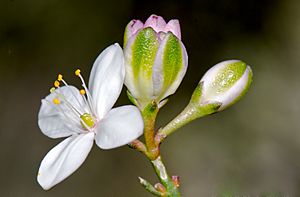Boronia busselliana facts for kids
Quick facts for kids Boronia busselliana |
|
|---|---|
 |
|
| Boronia busselliana in Wandoo National Park | |
| Scientific classification | |
 |
|
| Occurrence data from Australasian Virtual Herbarium |
Boronia busselliana is a special plant that belongs to the citrus family, called Rutaceae. It is only found in the south-west part of Western Australia. This plant is usually a thin herb or shrub that lives for many years. It has simple leaves that are spaced out and pretty pink, blue, or white flowers with four petals.
What it Looks Like
Boronia busselliana is a thin plant that can grow to be about 20 to 40 centimeters (8 to 16 inches) tall. Its branches, leaves, and flowers are all smooth, meaning they don't have any hairs. The leaves are simple and often fall off early. They are shaped like a cylinder and can be up to 12 millimeters (about half an inch) long.
The flowers grow either by themselves or in small groups of up to three. They appear where a leaf joins the stem. Each flower sits on a small stalk, called a pedicel, which is about 5 to 10 millimeters (0.2 to 0.4 inches) long.
Each flower has four sepals, which are like small, leaf-shaped parts that protect the flower bud. These sepals are egg-shaped with a thick center and are about 2 to 2.5 millimeters (0.08 to 0.1 inches) long. The four petals are oval-shaped and can be pink, blue, or white on top. Underneath, they are green or pink. These petals are about 8 to 12 millimeters (0.3 to 0.5 inches) long and have tiny, noticeable bumps called glands. The eight stamens (the parts that make pollen) and the style (part of the female flower organ) are thin and smooth. This plant usually blooms from September to October.
How it Got its Name
The plant Boronia busselliana was first officially described and named in 1875 by a scientist named Ferdinand von Mueller. He wrote about it in a book called Fragmenta phytographiae Australiae.
The very first plant sample used to describe this species was collected by Charlotte Harriet Bussell. She found it near the port in Geographe Bay. The second part of the plant's scientific name, busselliana, was chosen to honor her for collecting this important sample.
Where it Lives
This type of boronia plant grows on slightly raised areas and rocky spots, often in gravel or over a reddish type of soil or rock called laterite. You can find it in Western Australia, in an area stretching between Eneabba and Ongerup. It lives in several different natural areas that have similar plants and animals, including the Avon Wheatbelt, Esperance Plains, Geraldton Sandplains, Jarrah Forest, Mallee, and Swan Coastal Plain.
Is it Protected?
The Western Australian Government's Department of Parks and Wildlife has looked at Boronia busselliana. They have classified it as "not threatened," which means it is not currently in danger of disappearing.

